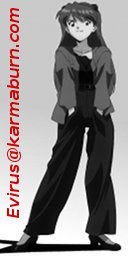|
|
Blog Archives:
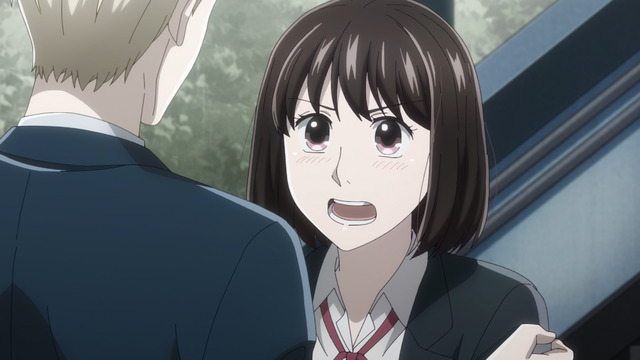
They're not flirting.
I started the Spring 2021 season with an entry covering both Koi to Yobu ni wa Kimochi Warui (It's Disgusting to Call This Love or KoiKimo) and Hige wo Soru. Soshite Joshikousei wo Hirou. (I Shaved. Then I Brought a High School Girl Home. or HigeHiro), so I guess I should have a post wrapping them up as well. I found KoiKimo to be a better series, perhaps because of its straightforward story. It also helps that KoiKimo leaves Ichika in control of her fate. It is ultimately Ichika's decision whether her relationship with Ryo will advance or not.
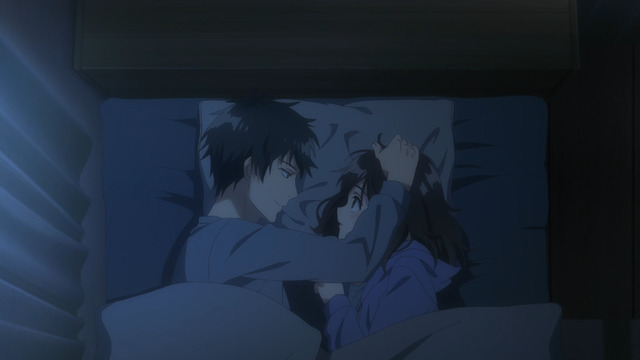
Platonic head pat.
Sayu does not have this luxury in HigeHiro. Maybe it's disingenuous to claim HigeHiro is about Yoshida "looking for something attractive to save" (my apologies to Liz Phair), but replace Yoshida's name here with "the audience's surrogate," and maybe it's not far off the mark. KoiKimo and HigeHiro both ended up where I expected, but Sayu had much less say over the path she took to get there.
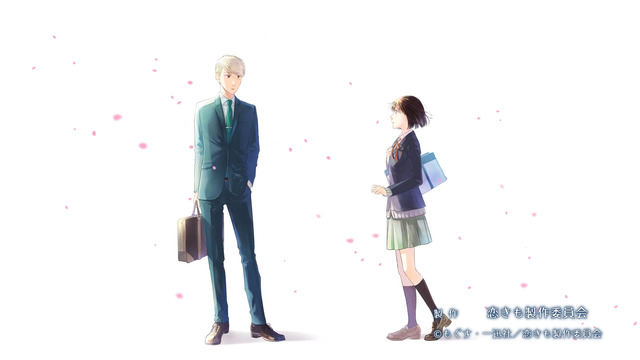
Making the end credits look more like the manga art was a nice touch.
In contrast, KoiKimo is an honest romance. There is no real mystery whether Ichika and Ryo will actually end up together or not, even though KoiKimo does introduce rival love interests for both leads. Moreover, the rivals are genuinely more sensible partners from every objective metric. However, the most obvioius impediment—the age gap between Ichika and Ryo—is never depicted as a meaningful obstacle. When it is finally viewed as a problem, its solution is entirely unsurprising.
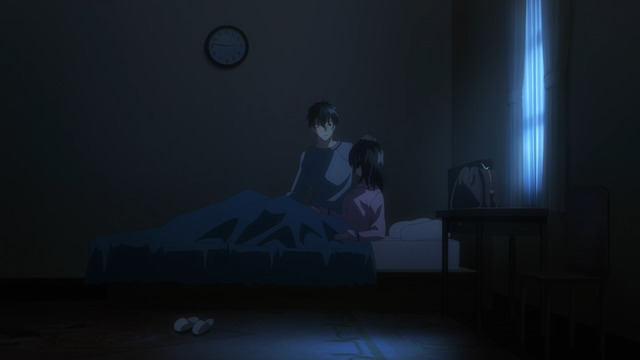
Platonic head pat.
The solutions to the challenges presented in HigeHiro are also fairly obvious, but the series insists on pantomiming a number of unconvincing feints. They're unconvincing because Sayu basically has no flaws, and Yoshida clearly feels something for her. He never has a reason to turn her away, and Sayu's rivals for Yoshida's attention are dubious love interests who quickly end up supporting Sayu anyway.
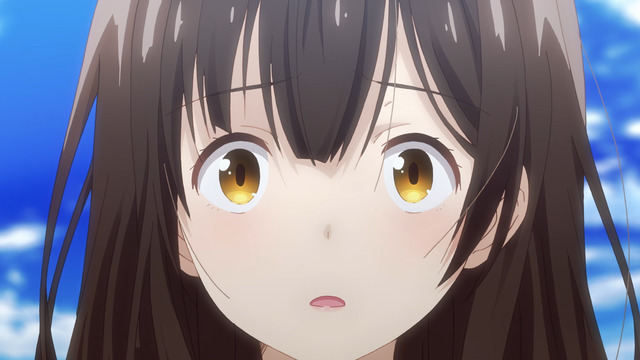
Relax, Sayu. Wonder Eggs are only 500 yen each.
In fact, Sayu's true adversaries are her lack of self-worth, her family's disinterest in her welfare, and the story's insistence at making Yoshida obtuse. Yoshida's behavior is baffling in HigeHiro, and not just because he denies being attracted to the sexually available high school girl living with him. Yoshida's behavior is baffling because he's willing to accept immediately on faith that Sayu would be better off returning to her home, without ever examining even the slightest bit the reasons why she ran away in the first place. It seems irresponsible to not at least contemplate the myriad awful situations that potentially compel teenagers to leave home and offer sex to strangers just to survive.
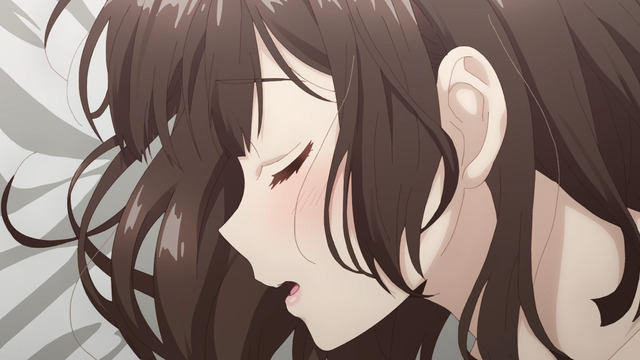
HigeHiro showed Sayu orgasming on screen.
Of course, the real reason Yoshida never asks is because the story can't let him or the audience know before the narrative is ready. It turns out the unpleasant situation Sayu fled wasn't that bad, but that's the case only because HigeHiro insists on rehabilitating its antagonists immedately after introducing them. This sort of cowardice is a significant weakness of HigeHiro, as it makes its conflicts fairly hollow. The challenges presented in KoiKimo are not intractable either, but at least they don't take on a fraudulent quality.
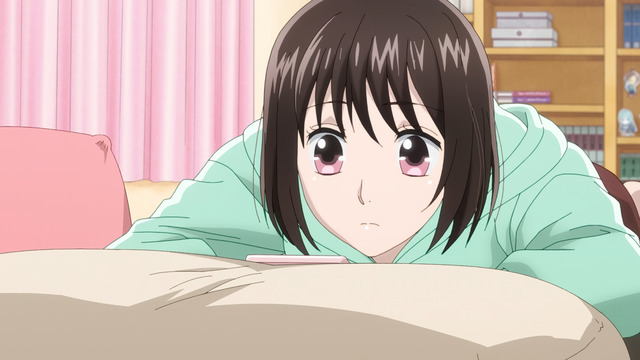
Ichika grew accustomed Ryo's nightly calls without realizing it.
KoiKimo succeeded by being forthright about its romance and committing to it unapologetically. In contrast, HigeHiro (like Yoshida himself) spends basically the entire series maintaining an unconvincing veneer of plausible deniability over whether or not Sayu is an actual love interest. At the risk of attracting accusations of being in favor of age-inappropriate pairings, I'm going to suggest HigeHiro does this to its detriment.
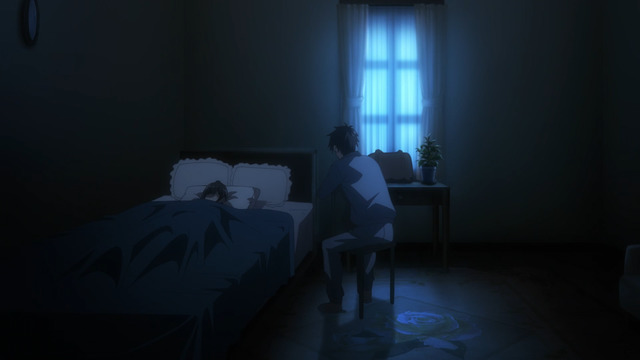
They had to put him in a chair watching her sleep
so people wouldn't insist they still fucked.
I suppose I can't speak for its source material, but the anime most certainly portrays Sayu as an eligible partner. Does HigeHiro provide Sayu with agency by having her test Yoshida's resolve each time she propositions him? Or does the series undermine Sayu's agency by presenting these moments solely so Yoshida can continue to rebuff her and showcase his unflagging integrity? I'm not answering this rhetorical, but I think we all know.
Posted in Hige wo Soru. Soshite Joshikousei wo Hirou., Koi to Yobu ni wa Kimochi Warui | Tags: 16-year-old love interests, Bad Things Happen to Good People, Bend Her Over a Kotatsu, Built for Sin, Christmas Cake, Compare and Contrast, Fan Service, Hanakana Distortion Field, Hanazawa Kana, Harem Comedy, Light Novels, Love Confessions, Love Triangle, Manga, May-December Romances, Plying Girls, Rape, Romance, Season Conclusion, Sex, Spoilers, Spring 2021, tsundere, Unrequited Love | Permanent Link
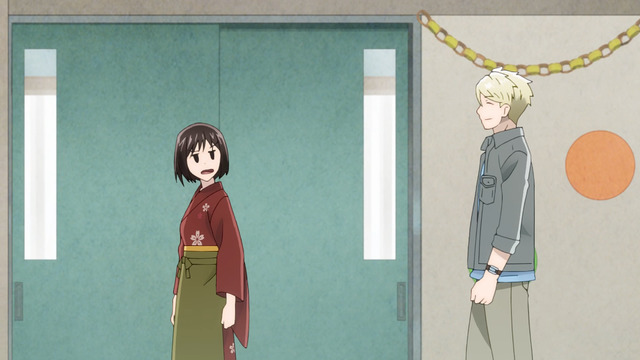
Stalker distancing.
News that the Spring 2021 anime season would feature TWO shows about adult men paired with high school girls created ripples across the Twitter, but even this mild outrage waned after viewers discovered neither show was as torrid as anticipated. Descriptions of Koi to Yobu ni wa Kimochi Warui (It's Disgusting to Call This Love, A.K.A. Koikimo) in particular concentrated on elements that ranged from misleading (characterizing its male lead as "a womanizer") to outright untruthful (e.g., calling him "sex-crazed...with a wandering eye for women"). At the risk of stereotyping too much, I suspect more attention should have been paid to the fact that the Koikimo manga is described as josei (i.e., for adult women) instead of seinen (i.e., for adult men who miss fucking teenage girls).
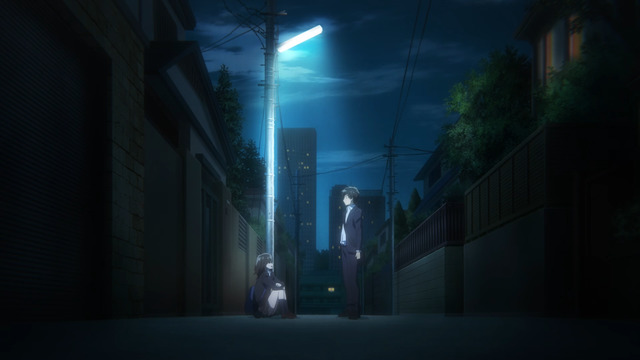
I was too bothered by Sayu's lack of luggage to make a Fate/stay night joke.
Curiously, Hige wo Soru. Soshite Joshikousei wo Hirou. (Higehiro: After Being Rejected, I Shaved and Took in a High School Runaway) seemed to attract less pre-season attention than Koikimo, but perhaps its original novels and manga adaption were already known well enough to deflect unwarranted speculation that it was going to be a smutty romp. This, despite its synopsis outright stating that its characters meet when the titular teenage girl, Sayu, offers sex in exchange for a place to stay. Instead, Higehiro is about a man, Yoshida, who insists he is not attracted to the JK crashing at his place. The series begins with Yoshida being rejected by his long-term crush (his boss at work, no less) who claims she is already seeing someone. He is so devastated that he seemingly does not even notice she was CLEARLY LYING.
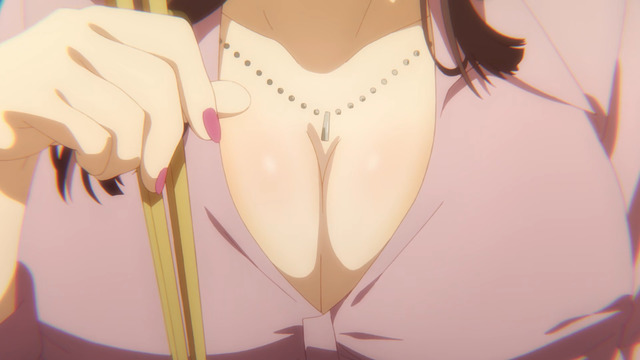
Dude, you're staring.
Higehiro also draws attention to Yoshida's insistence that he is not a "nice guy" for letting Sayu live with him without strings attached (unlike everyone else she has stayed with during her previous six months as a runaway), but rather that the other men she has known are despicable people. Yoshida also repeatedly insists he is not attracted to Sayu because he only likes women with large breasts, but then the show promptly undercuts him by immediately alerting (and repeatedly reminding) the viewer that Sayu's boobs are also comfortably big.
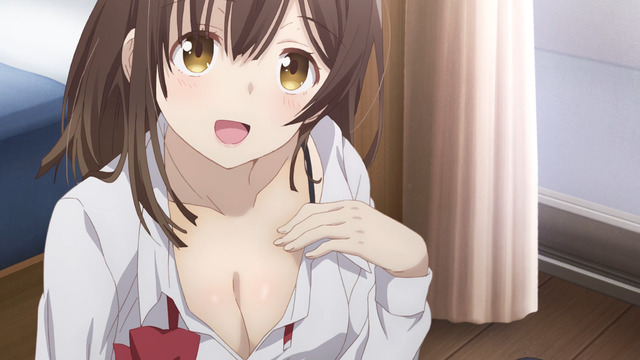
Higehiro even quantifies the comparison.
This is where I lose the ability to predict the path Higehiro will take. There is enough fan service and "male gaze" to the anime that we are obviously supposed to see Sayu as a legitimate love interest of Yoshida's, despite (or perhaps because of) his loud denials. But the show also retains the harem elements by keeping the CLEARLY LYING boss lady and deliberately slapdash co-worker near as potential romantic rivals. If I had to guess how this story ends, I would expect Yoshida's support to put Sayu on a path to success before re-uniting the two after a multi-year timeskip apart that has given Sayu time to become a self-sufficient adult with even bigger boobs than ever. Alternatively, we'll get a cop-out non-ending ending, potentially with all four of them living together for contrived reasons.
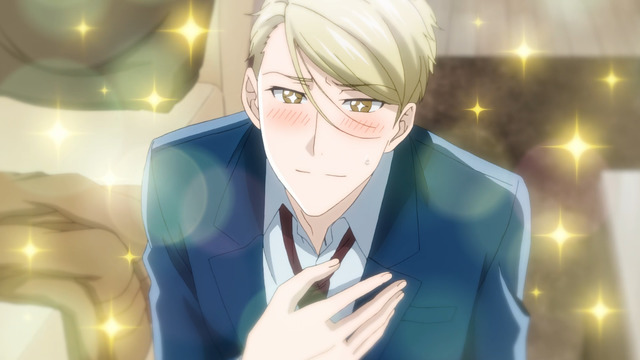
You can tell he's sincere because of the sparkles.
While Higehiro is about a man who denies being attracted to the teenage girl living with him, Koikimo is about a man openly and aggressively wooing a high school girl 10 years his junior. At this point, I think it is necessary to acknowledge the tropes that govern this story's boundaries. Ryo and Ichika meet by chance and a suspension bridge moment sparks his sudden obsession with Ichika, who is coincidentally classmates with Ryo's kid sister, Rio. Fortunately for Ryo, his sister not only approves of his infatuation with her friend, but even volunteers as his wingman to provide opportunities for him to get closer with Ichika.
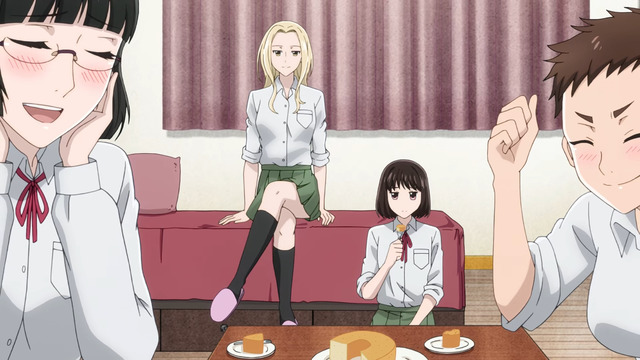
Rio's anime bed is made of concrete.
Moreover, Ichika's own mother approves of Ryo's courtship, despite Ichika's clear displeasure. It is probably worth pointing out that Ryo has apparently never had to pursue a love interest before. He is not a pick-up artist chasing after fresh prey. Instead, girls and women have thrown themselves at him his entire life (Ichika's and Rio's classmates all unanimously agree Ryo is exceptionally handsome), so this is an entirely new experience for him.
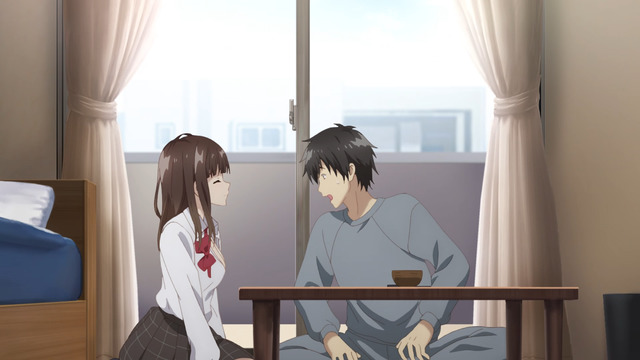
Dude, you're staring.
So what are Koikimo and Higehiro both missing? Lust. In the case of Koikimo, Ryo is clearly, genuinely smitten with Ichika, but he is arguably more drawn to her disinterest in him than he is to her physical appearance. Ichika is presented as being fairly unremarkable among her peers, and her own best friend describes her as "normal" (although at least one boy at her school has taken a liking to her). In the case of Higehiro, it takes three episodes of the show loudly signalling that Sayu is comely and sexually available before Yoshida finally admit he finds her attractive. However, his refusal to sleep with her is predicated on a critical, foundational cornerstone to the narrative's integrity, so I don't expect the story can too easily reverse this stance even if the audience comes to think he protests too much.

She is upset because she is pleased.
After four episodes of Koi to Yobu ni wa Kimochi Warui and three episodes of Hige wo Soru. Soshite Joshikousei wo Hirou., I enjoy Koikimo more than Higehiro. Neither series is especially realistic (although I could believe Higehiro, despite the melodrama, were it not for the CLEARLY LYING Christmas-cake boss lady and the co-worker who deliberately fucks up her work for Yoshida's attention), but I find Koikimo more amusing. I can't rule out the possibility that I'm simply more enamored of Ichika's seemingly endless barrage of disgusted faces than I am with Sayu's "pretty big for a high school girl" bosom, though.
Posted in Hige wo Soru. Soshite Joshikousei wo Hirou., Koi to Yobu ni wa Kimochi Warui | Tags: 16-year-old love interests, Bend Her Over a Kotatsu, Built for Sin, Christmas Cake, Compare and Contrast, Harem Comedy, Light Novels, Love Confessions, Love Triangle, Manga, May-December Romances, Plying Girls, Rape, Romance, Season Introduction, Sex, Spring 2021, tsundere, Twitter, Unrequited Love | Permanent Link
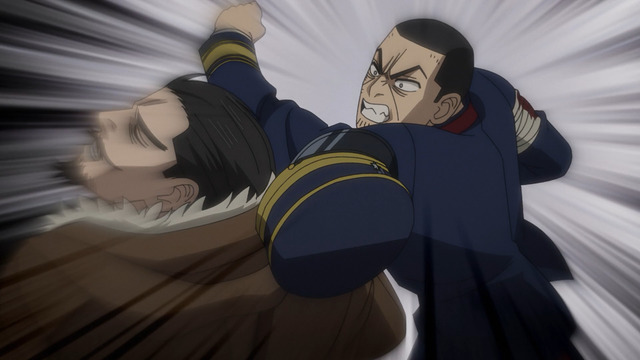
He had it coming.
Some of the shows I covered in previous posts (1st, 2nd, 3rd) included remakes and sequels or continuations. Well, there are more. Golden Kamuy also resumed this season. It's described as the third season, but really it's just the third cours of series. The anime remains as good as ever, thanks to the strength of the source material. In fact, the anime has improved by thus far avoiding the 3DCG pitfalls that unfortunately distracted from the first cours.
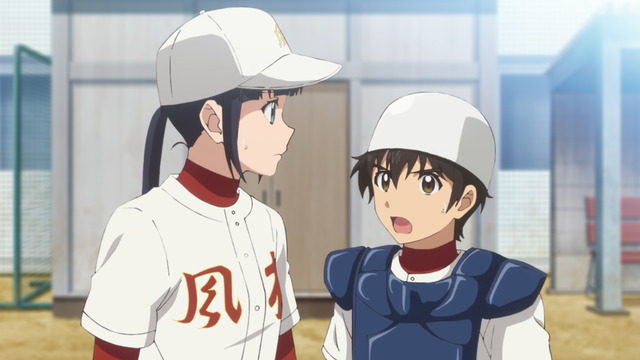
Daigo is short.
Major 2nd S2 remains consistently good as anyone who has ever followed the franchise would expect. The current arc again revisits events from the first season of Major 2nd, but it should still be accessible to new viewers. Well, they can be new to Major, but it probably helps to know at least a little about baseball. At a minimum, it will reinforce how relatively lucky the new girl has been so far despite making a lot of basic mistakes.
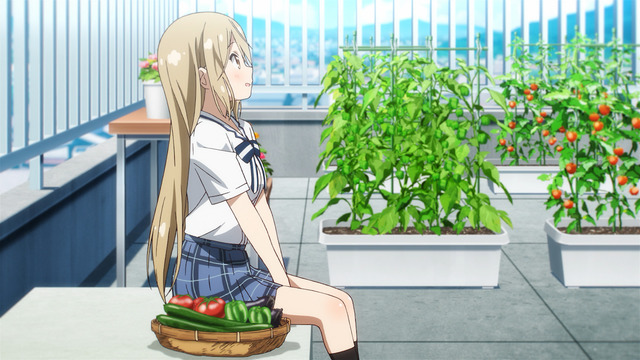
This is not actually a room.
One Room is also back for a third season. It's first-person-anime gimmick seems a bit lewder this time around than I remember from the previous installments. However, it's still fairly tame even though the first girl found an excuse to whip off her clothes by the second episode. I guess since the characters only gets three episodes for each arc they have to make the best of their opportunities.
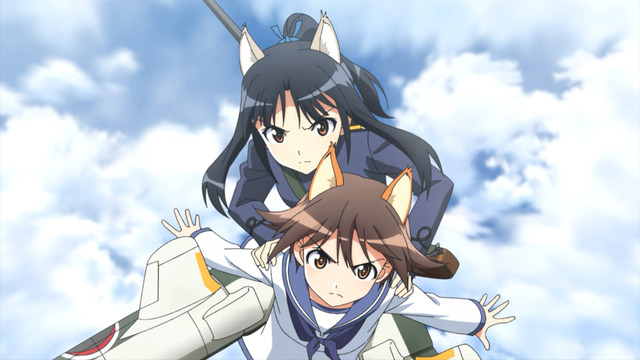
Strike Witches is still Miyafuji's show.
Going the other way, Strike Witches: Dai-501 Tougou Sentou Koukuudan ROAD to BERLIN (the third "proper" season of Strike Witches) is definitely less lewd now compared to how it started out. The first season of Strike Witches featured uncensored casual nudity on a fairly regular basis. This season started with an appearance by Sakamoto Mio wearing pants, of all things. PANTS!
Posted in Golden Kamuy, Major, Major 2nd, Major 2nd S2, One Room, Strike Witches: Road to Berlin | Tags: 3D, Air Power, Autumn 2020, Bad Things Happen to Good People, baseball, Bend Her Over a Kotatsu, Childhood Friend, Fan Service, Girls With Guns, Hanakana Distortion Field, Hanazawa Kana, Kadowaki Mai, Koshimizu Ami, Manga, Mecha Musume, Miyuki Sawashiro, Plying Girls, Romance, Season Introduction, Sequels, Short Shows, Superlovely Character Designs, war, War Is All Hell | Permanent Link
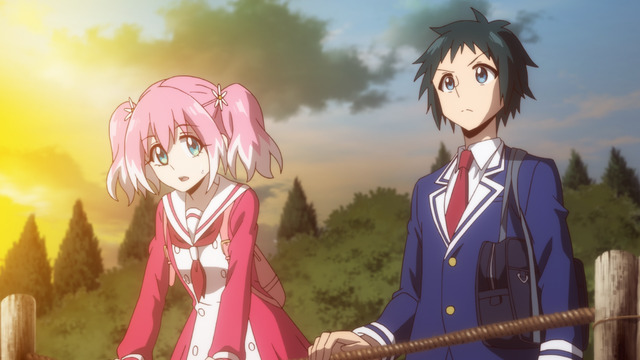
The front of Nanao's uniform reminds me of a Heinz bottle.
Adding onto this post about shows airing during the Autumn 2020 cours, my early top show is Munou na Nana (Talentless Nana) which had a surprisingly solid first episode, albeit one that relied on breaking from expectations, so you're better off avoiding spoilers and watching the first episode blind. Unfortunately, it looks as if the source manga isn't rated highly, so potentially the story doesn't fare so well later on. More optimistically, perhaps the low scores are merely due to problems the anime adaptation can fix.
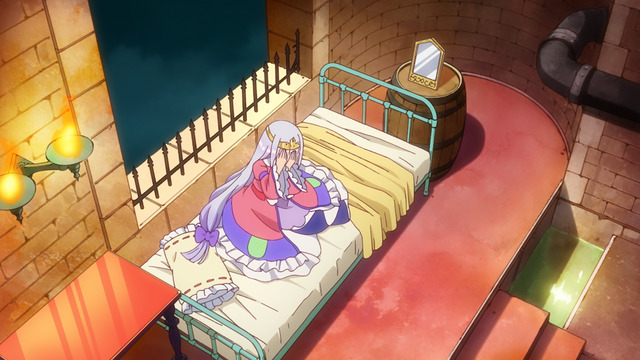
The horror of an anime bed made of concrete.
I'm more pessimistic about Maou-jou de Oyasumi (Sleepy Princess in the Demon Castle) which is one of those shows with a neat idea that runs the risk of wearing out its welcome if it turns out to only offer one basic joke that it repeats ad infinitum. I think the source manga remains well liked, so maybe I should have more faith it its potential for creativity.
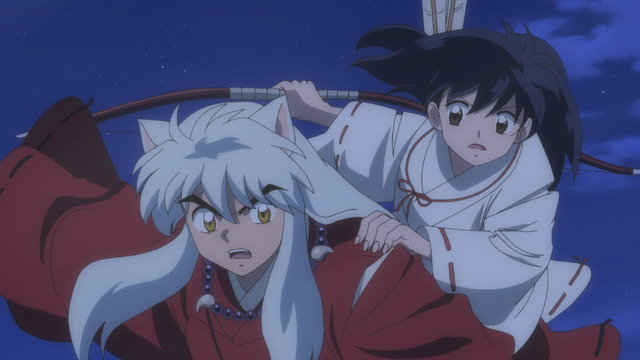
I don't even know why Inuyasha himself is a dog except that it's in his name.
Despite being almost entirely ignorant about InuYasha, I'm reasonably sure its sequel (spinoff?) will probably be at least sort of good thanks to having a respectable pedigree. Kyoukai no Rinne is actually the only Takahashi Rumiko thing I've ever seen, but that was pretty good. Her other works are popular, and I remember people being nuts for InuYasha back in the day, so Hanyou no Yashahime (Yashahime: Princess Half-Demon) at least has odds in its favor.
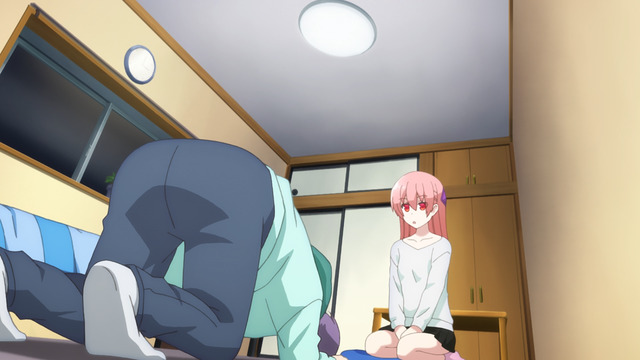
Mi casa es Tsukasa.
Tonikaku Kawaii (TONIKAWA: Over The Moon For You) also has a pedigree, but not one quite as good. It has probably already referenced its creator's other works a few times by now unbeknownst to me, though. The first two episodes were fine, but not outstanding, and I'm already quite tired of Potato-kun's penchant for freaking out. It's one of those "comic" behaviors that isn't as objectionable in manga form, but doesn't translate well to anime. I'm also worried a bunch of wacky cockblockers will move in with the couple. In fact, I can probably think of a whole lot of different ways this could go wrong, even though I think the manga remains popular. There are a lot of shows this season, so I'm not going to be as patient with it as I might have been just a few months ago.
Posted in Hanyou no Yashahime, InuYasha, Kyoukai no Rinne, Maou-jou de Oyasumi, Munou na Nana, Tonikaku Kawaii | Tags: 16-year-old love interests, ass shot, Autumn 2020, Bedrooms, Bend Her Over a Kotatsu, First Episode, Love Confessions, Manga, Mysteries, Romance, Season Introduction, Shounen Jive | Permanent Link
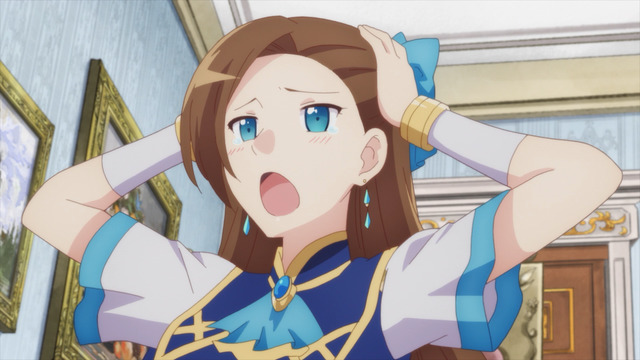
It's not easy being rich.
While a significant number of shows from the Spring 2020 anime season are delayed, Otome Game no Hametsu Flag shika Nai Akuyaku Reijou ni Tensei shiteshimatta… (My Next Life as a Villainess: All Routes Lead to Doom!) marches on. Hamehura (alternatively Hamefura, but really now: Bakarina) is a solid adaptation of the popular web novel turned light novel. I've enjoyed the manga adaptation as well, thanks to some great character designs and relentless mugging which the anime sensibly adopts as well.
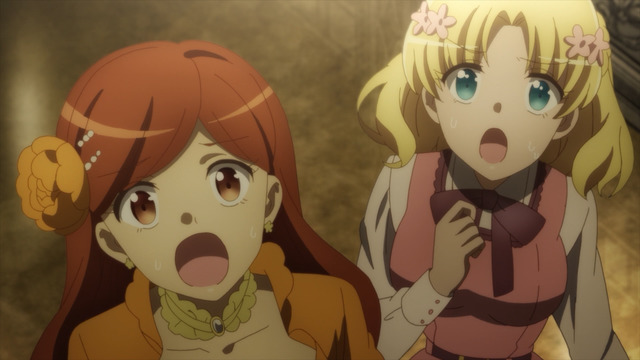
Relax, ladies, it's fine.
As for the show itself, the Bakarina anime features our clueless antagonist's ongoing efforts at avoiding either exile or a grisly demise, all while entirely ignorant that she's actually the protagonist now and entirely too successful at currying favor among her peers and erstwhile rivals. Clueless love interests in harem anime are nothing new (see, for example, Ichika in IS <:Infinite Stratos>), but I find Bakarina herself an amusing character and sort of endearing. At a minimum, that differentiates her from Potato-kun from such-and-such series quite a bit.
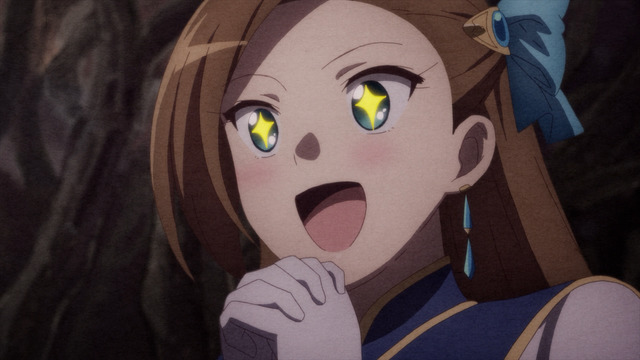
Fruits Basket face.
If I had to identify why this distinction exists, I want to say it's because those typical harem comedy protagonists who remain oblivious to all the potential love interests hurling their undergarments at them tend to be in that position solely because the story says that's just the way it is, and not as a result of any qualities or efforts on their parts—at least not in any reasonable capacity. Catarina Claes, on the other hand, is fully committed to making sure all of these other characters like her as much as possible and get along with each other as well. That she doesn't realize she has already long accomplished this and is on the verge of collapsing her world into a harem comedy singularity sort of makes me like her too.
Posted in Otome Game no Hametsu Flag shika Nai Akuyaku Reijou ni Tensei shiteshimatta… | Tags: Bend Her Over a Kotatsu, Harem Comedy, Light Novels, Manga, Reverse Harem, Romance, Season Introduction, Spring 2020, Unrequited Love | Permanent Link

Iwanaga is not a chuuni. She's probably just re-adjusting her eye.
Although I really enjoyed the In/Spectre (Kyokō Suiri, or Invented Inference) anime, I was surprised at long the "Steel Lady Nanase" arc lasted. (Specifically, it takes up the entire rest of the cours once it starts.) I'm reading the manga now, and these volumes include afterwords by the original author that shed light on the situation.
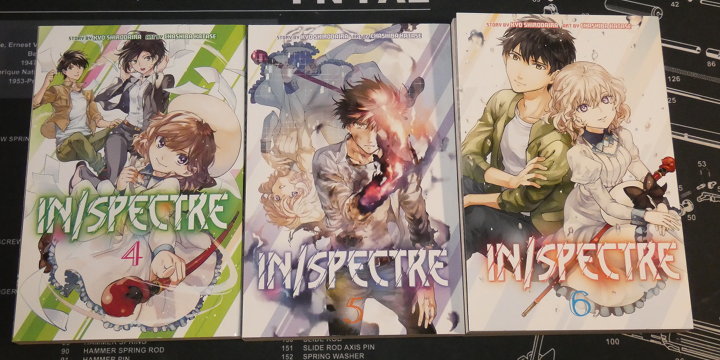
Despite appearance, Kuro is also not a chuuni. He is tsundere for his own girlfriend, though.
Kyokou Suiri was originally one book. This received a manga adaptation which spanned six volumes. The author claims he gave the mangaka essentially full control over the visuals and a lot of latitude to apply appropriate changes while adapting the book to manga form. This hands-off approach seems to have worked, as the manga proved popular enough to inspire the original author to write more stories (while lamenting the Invented Inference title no longer really fit the subject matter of the later material).
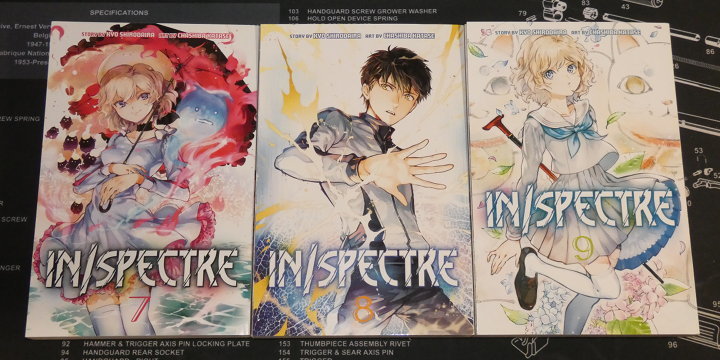
Iwanaga is wearing a school uniform because one of the stories takes place while she was in high school.
Notably, the original author (Shirodaira Kyo) wrote the subsequent material as short stories, rather than collaborating with the mangaka (Katase Chasiba) to produce scripts for the manga, reasoning that doing things differently at this point could inadvertently disrupt the chemistry of whatever it was that made the manga adaptation of the original book turn out so well. Well, he wasn't wrong. The five volumes following the "Steel Lady Nanase" arc are at least as good, if not better.
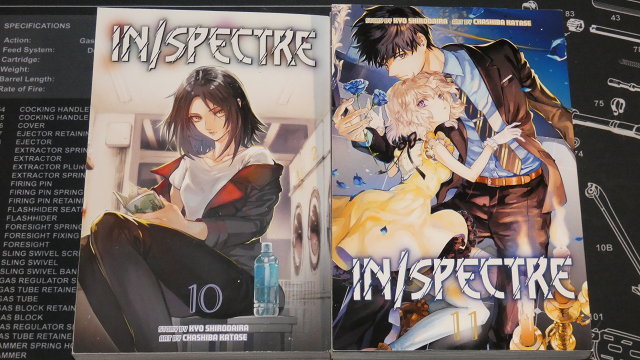
Rikka's not dead, she just looks like that.
As you may have guessed, the In/Spectre anime is itself an adaptation of the manga, and not a separate adaptation of the original book (which I've not had an opportunity to read). As adaptations go, it's very close, really only moving the arc with the giant snake so that it takes place before the Steel Lady Nanase arc instead of after it. I don't know if there are any plans to produce a sequel to the anime, but there is certainly enough source material to support one. All of the subsequent stories in the volumes I've read are shorter than the Steel Lady Nanase one, but at least three of them are long enough to span multiple episodes. Thankfully, the longest of these concluded at the end of volume 11, instead of with a cliffhanger leaving the reader waiting until the release of volume 12—that one won't be out until the end of August.
Posted in In/Spectre, Literature, Loot, Manga | Tags: Bad Things Happen to Good People, Bend Her Over a Kotatsu, Detectives, Hair, Idols, Love Confessions, Mysteries, Sex, tsundere, Unrequited Love, Winter 2020 | Permanent Link
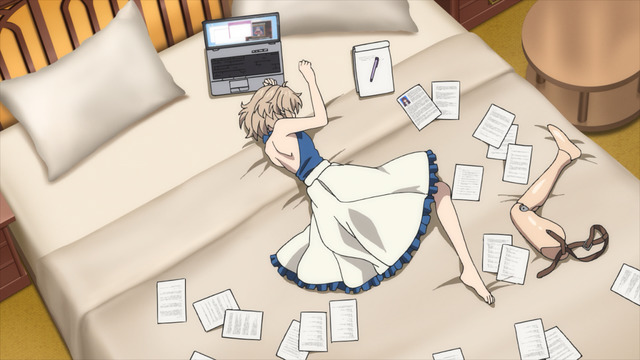
Nearly the entire seventh episode takes place in a hotel room.
Before the season started, I wasn't expecting too much out of Kyokou Suiri (In/Spectre), but it's really turning out to be quite enjoyable. There is a significant amount of dialogue in the series, as the characters spend a lot of time discussing the details from various angles first before tacking the mysteries they're facing. Consequently, there is a lot more talking and much less neck kicking than the trailer led me to believe. Thankfully, I do find the banter entertaining, and the characters are pleasant to have around. The lead male doesn't seem to get excited very often, which is a huge improvement over anime's penchant for making these dudes spazzes.

These two are okay together.
The pacing in Kyokou Suiri is slower than I expected, though. In fact, it's slow enough that I'm starting to wonder if the ongoing Nanase mystery is going to take up the entire cours. I suppose this means a non-ending "read the books" ending is all but assured. I'd rather In/Spectre turn into a long-running series (it could take over the yokai niche for GeGeGe no Kitarou, which I think is ending this season after a two-year run), but the chances of that seem pretty slim. As far as I know, it's only scheduled for 12 episodes, and I'm not certain it's been popular enough to have the, uh, legs for more.
Posted in Books, In/Spectre | Tags: Bad Things Happen to Good People, Bend Her Over a Kotatsu, Detectives, Idols, Love Confessions, Winter 2020 | Permanent Link

Hozuki is still Best Girl even though she's nice to people now.
The second cours of Kono Oto Tomare! Sounds of Life continues to satisfy with its steady stream of people being judgmental assholes. That bit from the first cours where smug douches jump to conclusions based on false accusations and totally unfair assumptions reappears here, but still manages to avoid crossing into irritating territory. It's a fine line, but I like how the show doles out the inevitable comeuppance and vindicates the accused.
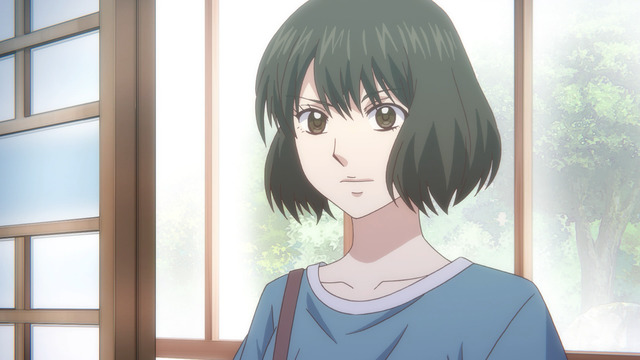
You're okay. Try not to drive into a hedge.
I don't know how the source material is paced, but a bunch of characters are piling into the show as of the most recent episode, presumably in a rush to work in all the bits related to the upcoming competition before the season ends. This does work to its detriment, but it's the sort of thing I'm willing to excuse since the sum of the parts totals favorably. I'm not expecting further episodes of Kono Oto Tomare! after this season ends, but I'd watch more.
Posted in BEST GIRL, Kono Oto Tomare! Sounds of Life | Tags: 16-year-old love interests, Autumn 2019, Bad Things Happen to Good People, Bend Her Over a Kotatsu, Douche Bags, Hair, Instrument Goggles, Music, tsundere | Permanent Link
|
|










